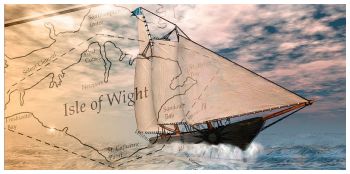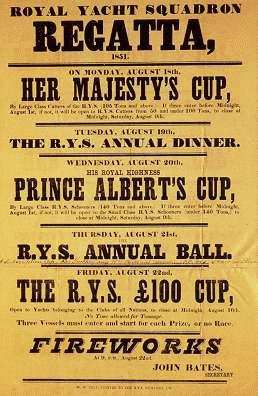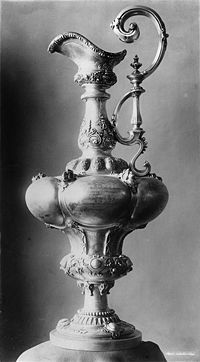Yves GARY Hits: 4911
Category: 1851 : THE £100 cup
 According to an article by the Royal Yacht Squadron :
According to an article by the Royal Yacht Squadron :
The cup's name comes from the yacht America which, in 1851, won the Royal Yacht Squadron's race round the Isle of Wight for a Cup of One Hundred Sovereigns (not guineas – the cup is often referred to mistakenly as the Hundred Guinea Cup, by which name it became known in America where it was subsequently engraved).
The cup is named after the yacht, not after the country that held it for so long. From contemporary accounts of the challenges the Americans seem to have used pounds (sovereigns) and guineas interchangeably. 100 guineas would have been £105.
 The cup is sometimes mistakenly referred to as The Queen's Cup. This misnomer appears to have arisen from a speech given on the victorious return of America's owners to the New York Yacht Club; this was widely reported and the name stuck. The Queen did present a cup each year to this club but that race was only open to Royal Yacht Squadron yachts: in 1851 to cutters of between 50 and 100 tons. She did however present cups to other yacht clubs and America was initially entered to race for The Queen's Cup of the Royal Victoria Yacht Club at Ryde on the Isle of Wight, just across the water from Portsmouth. This may have been the source of the Americans' confusion about the cup's name. Alternatively, the course round the Isle of Wight was known as The Queen's Course so that also may account for the confusion.
The cup is sometimes mistakenly referred to as The Queen's Cup. This misnomer appears to have arisen from a speech given on the victorious return of America's owners to the New York Yacht Club; this was widely reported and the name stuck. The Queen did present a cup each year to this club but that race was only open to Royal Yacht Squadron yachts: in 1851 to cutters of between 50 and 100 tons. She did however present cups to other yacht clubs and America was initially entered to race for The Queen's Cup of the Royal Victoria Yacht Club at Ryde on the Isle of Wight, just across the water from Portsmouth. This may have been the source of the Americans' confusion about the cup's name. Alternatively, the course round the Isle of Wight was known as The Queen's Course so that also may account for the confusion.
 The cup itself, a bottomless silver ewer weighing 134 ounces and standing 27 inches high, was purchased from Robert Garrard the jeweller in 1848 and subsequently presented to the RYS by Lord Anglesey. As Lord Uxbridge he had been a founder member of the club in 1815 and he was still an active yachtsman in 1851 with his cutter Pearl. In those days cups were not returned but were won outright. The cup, with the $25,000 for which they had sold the yacht America after their brief but successful sojourn in England, went to America with its new owners.
The cup itself, a bottomless silver ewer weighing 134 ounces and standing 27 inches high, was purchased from Robert Garrard the jeweller in 1848 and subsequently presented to the RYS by Lord Anglesey. As Lord Uxbridge he had been a founder member of the club in 1815 and he was still an active yachtsman in 1851 with his cutter Pearl. In those days cups were not returned but were won outright. The cup, with the $25,000 for which they had sold the yacht America after their brief but successful sojourn in England, went to America with its new owners.
It was initially proposed that the cup be melted down and souvenirs made for the America syndicate members - which would have saved much trouble and many fortunes! However, in 1857 it was presented to the New York Yacht Club as a perpetual challenge trophy. Not until 1870 was it first raced for as The America Cup. Known today of course as The America's Cup, many books have been written on the history of this great competition.
The cup is engraved with the names of all the yachts that raced America in 1851 with the exception of the runner up Aurora. When Queen Victoria asked about yachts following America up the Needles Channel she was reputedly told 'There is no second ', a phrase later used to great effect in a speech by Daniel Webster in America. The Queen waited for Aurora to appear before returning to Osborne but, as far as the cup is concerned, the phrase is true.
